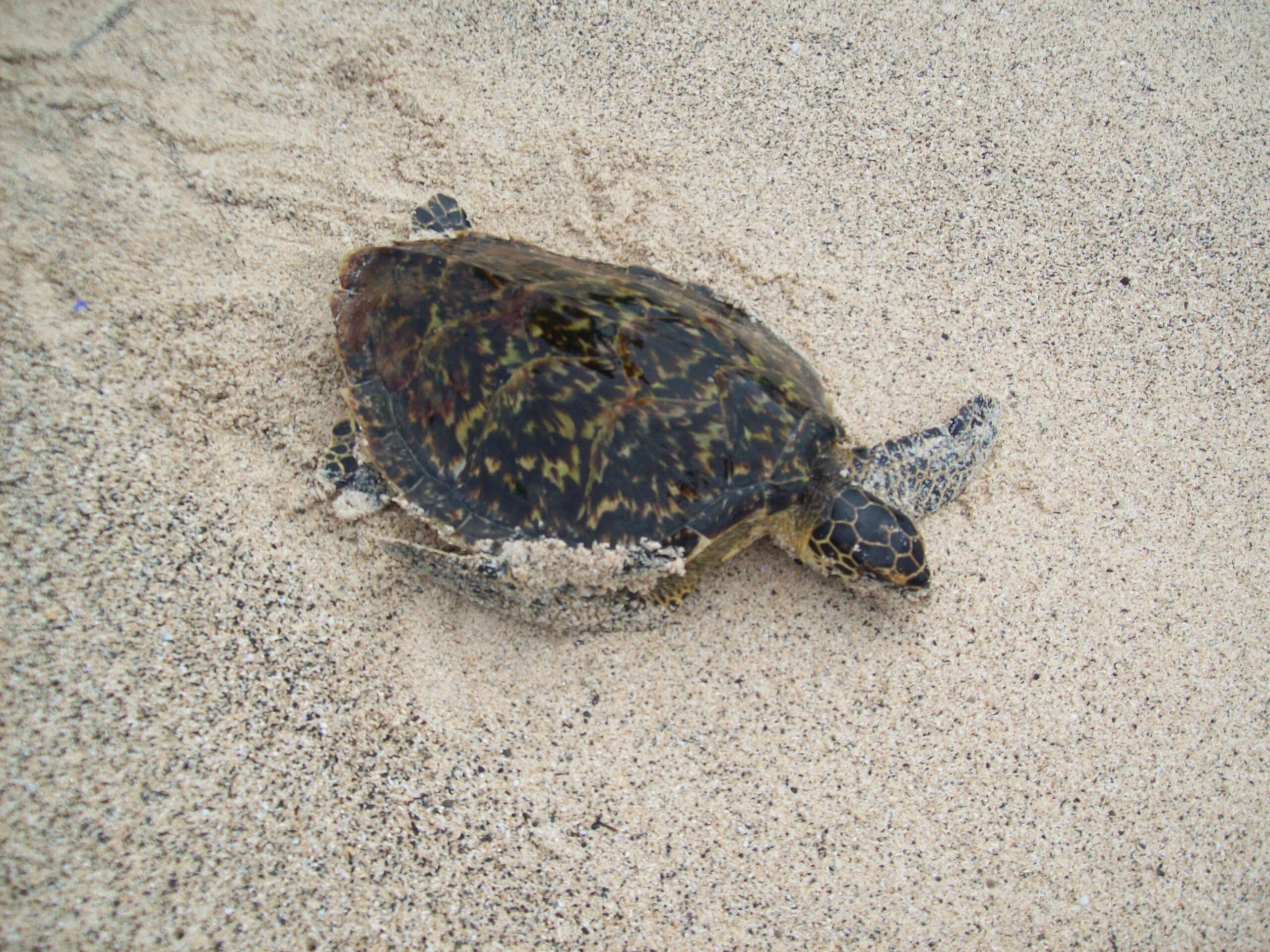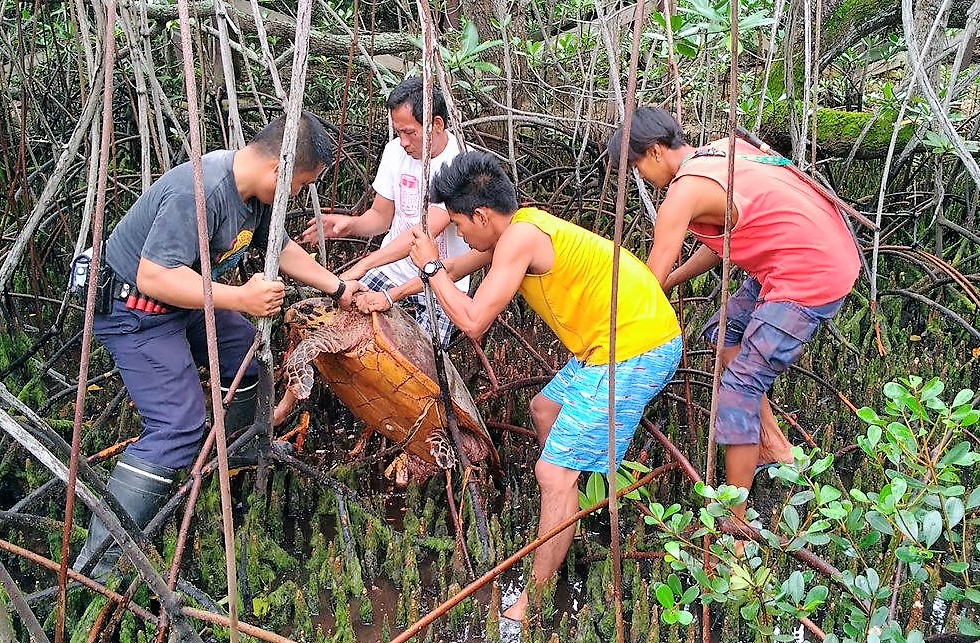Text and Photos by Henrylito D. Tacio
“I actually live near the area but this is my first time hearing that there is an (ecological park) in the middle of the city. I am amazed that we still have environmental sites that students can visit face-to-face,” Ala, a Grade-12 student from Emar Human Environmental College, Inc.
“I realized how careless some people are with their trash, not knowing that it will eventually end up in our seas,” she continued. “Improper waste disposal has such a big effect on the creatures living in the sea, no matter how small the size of the trash is.”
Ala shared her views after hearing the story of the rescued pawikan named Agdao, who died after ingesting plastic. It was turned over to the Aboitiz Cleanergy Park, but the veterinarians were unable to save the pawikan.
Ala is one of the 18 senior high school students from Davao City who joined the recent PawiCAMP held at sitio Punta Dumalag in Matina, Aplaya. PawiCAMP is an annual day camp dedicated to the protection and preservation of pawikan.
The island of Punta Dumalag is a nesting ground for marine turtles, locally known as pawikan. The 2-kilometer stretch of the white sand peninsula is part of the 37-hectare Marine Protected Area (MPA) that was established through Council Resolution No. 02504-03. Swimming is not allowed in the area.
The Aboitiz Group, which owns eight hectares in the southeastern portion of the island; the total land area is about 37 hectares. As its corporate responsibility, it decided to convert the place into a biodiversity learning center, which would be managed by its subsidiary, the Davao Light and Power Company (DLPC).
They called it Aboitiz Cleanergy Park. As a rescue center facility for the endangered pawikan, it works in tandem with the Department of Environment and Natural Resources and the local government unit of Davao.
“Our aim is to influence the youth and the community to be environmentally aware and to protect endangered species like the sea turtles. We also conduct annual mangrove planting and coastal clean-up activities as well as seminars with other institutions and the MOHSG participants,” said Glenn Robledo, Vice President for Community Development of Junior Chamber International (JCI) Davao, Inc.
JCI Davao is a long-time partner of Aboitiz Cleanergy Park in organizing the annual PawiCAMP. “This is part of our support to the United Nation’s Sustainable Development Goal (14), which aims to conserve life below water,” Robledo added.
Marine turtles are among those creatures that live below water. They belong to the order Chelonia, an order of reptiles that has existed and flourished since prehistory with very little change in their basic structure.


Of the eight species of marine turtles known to man, five of them can be found in the Philippines. These are the Green Sea (known in the science world as Chelonia mydas), Hawksbill (Eretmochelys imbricata), Loggerhead (Caretta caretta), Olive Ridley (Lepidochelys olivacea), and Leatherback (Dermocheyls coriacea).
The three others, which cannot be found in the country, are the Kemp’s Ridley (Lepidochelys kempi), Flatback (Chelonia depressa), and Black Sea (Chelonia agassizi).
Unfortunately, all eight species are listed under Appendix I of the Convention on International Trade of Endangered Species of Wild Fauna and Flora, which means the trade of these species and subspecies is strictly “prohibited except for educational, scientific or research and study purposes.”
The Conservation of Nature and Natural Resources has also classified the eight species as endangered. This is so because “their populations are in danger of extinction and whose survival is unlikely if the causal factors continue to operate.”
The Philippines is a signatory of the Convention on International Trade in Endangered Species of Wild Fauna and Flora and implements the Pawikan Conservation Project nationwide through the Protected Areas and Wildlife Bureau of the Department of Environment and Natural Resources. Since 2001, hunting, sale, and killing of marine turtles have been banned in the country.
But despite sincere efforts by the government and some environmentalist groups to save marine turtles from becoming extinct in this part of the world, the decimation of the endangered species continues unabated.
“All of the species found in our country are endangered except for the Hawksbill which is critically endangered,” said Dr. Arnel “AA” Yaptinchay, founder and director of the Marine Wildlife Watch of the Philippines (MWWP). “The only sure thing is that marine turtle populations are under tremendous threats and if these are not stopped, extinction is imminent.”
Haribon Foundation for the Conservation of Natural Resources believes so, too. “Unless we, Filipinos, seriously take on the task of protecting the much-endangered marine turtles, these ancient creatures will soon be gone (from our waters),” Haribon, a pioneer of the environmental movement in the Philippines, said in a statement.
Overhunting has been cited as one of the main reasons for the decline of the marine turtle population in the country. Since the dawn of history, the meat of marine turtles has augmented the diet of man. Seventeenth-century seafaring men used turtles as ship’s provisions – their ability to stay alive for months without food and water ensured a steady supply of fresh meat without storage problems.
Marine turtles are also hunted for their commercial value. In the past, the country was one of the major exporters of turtle by-products, such as turtle wall décor, jewelry pieces, shell-backed guitars, and bags and shoes.
“We can dramatically reduce this demand if we ourselves desist from patronizing these products,” said Haribon. “Put a stop to the massacre by becoming aware of the plight of marine turtles.”
Aside from overhunting, another factor that endangers the survival of marine turtles is the wanton gathering of marine turtle eggs. Mistakenly touted as having aphrodisiac prowess, the eggs taste just like boiled chicken eggs.
The degradation of their habitat has also contributed to the decimation of marine turtles in the country. The ruin of the territories results from increased effluent and contamination from coastal development, construction of marinas, increased boat traffic, and harvest of near-shore marine algae resources.
Marine turtles are likewise decimated by plastics. About 20% – or half a million tons – of the 2.7 million tons of plastic waste the Philippines generates annually leaks into the oceans, according to the 2015 report on plastic pollution by the Ocean Conservancy.
“Plastics endanger marine life and other animals, because they can mistake a piece of plastic for food when it isn’t,” a study pointed out. After eating plastic, they starve and die. Another study published in the journal Scientific Reports suggests that ingesting even a single piece of plastic can be deadly for these marine animals.
Some years ago, some fishermen found off the coast of barangay 78 in Davao City a dying green sea turtle, which was brought to a non-government organization for treatment. Hours later, it died and American marine biologist Darrell Blatchley found plastic bags which were extracted from the turtle’s stomach.
A report from the Ocean Conservancy ranked the Philippines third (after China and Indonesia) among the countries with the highest source of plastic ocean pollution, generating 1.88 metric tons of mismanaged plastic garbage annually.
The journal Endangered Species Research also reported that marine turtles “being tangled up in lost fishing nets, plastic twine and nylon fishing line, as well as six-pack rings from canned drinks, plastic packaging straps, plastic balloon string, kite string, plastic packaging and discarded anchor line and seismic cable.”
Dr. Brendan Godley, professor of Conservation Science at the University of Exeter and leader of the study, commented: “Plastic rubbish in the oceans… is a major threat to marine turtles. We found, based on beach strandings, that more than 1,000 turtles are dying a year after becoming entangled up, but this is almost certainly a gross underestimate. Young turtles and hatchlings are particularly vulnerable to entanglement.”
Marine turtles are also being threatened by climate change. “Potential impacts of global warming, such as projected sea level rise, can lead to shoreline erosion of small, low-lying tropical islands,” MWWP says. “Waves running up the shore during storms will wet the nests and increase egg mortalities at rookeries in these small islands, possibly decreasing the overall reproductive success of the marine turtle population.”

Unknowingly, most Filipinos don’t know that tourism may also play a big part in making marine turtles extinct. “Tourism in natural places that does not take into account the effect they have on the environment is the threat,” explained Dr. Yaptinchay. “In the Philippines, where it seems that every inch of our beaches will soon be developed for tourism, this will become a big threat for marine turtles.”
According to Dr. Yaptinchay, development of the coast where buildings are to be constructed will displace marine turtles from one of their most important life cycle habitats, referring to the nesting beach.
“Lights, infrastructure, noise, domestic animals, and pollution will not only disturb those nesting females but also their hatchlings,” he said. “Marine turtles will not nest when disturbed.”
Studies have shown that marine turtles spend most of their life in the sea and get all the things they need there. They even mate in the sea. But when the time comes to lay their eggs, the females return to shore, usually in the same place where they were hatched.
“If you imagine a first-time nester approaching its place of birth, how much do you think of its birth place or nesting beach remains over the last 35-50 years?” Dr. Yaptinchay asked. “I would guess there would be very little space left for it to nest and enough disturbance developed to shoo it away. We are preventing them from fulfilling their life purpose. For me this is very tragic.”
In some instances, some tourism facilities view marine turtles as attractions. “This is fine if you view marine turtles from a distance, but most (beach owners) are greedy and would take a turtle and put it in a tank for secured viewing for their guests,” Dr. Yaptinchay said.
But what he considered as worrisome is when beach owners would tie the turtle to a tree. “This has happened and is still happening,” deplored Dr. Yaptinchay.
Under sections 27 and 28 of Republic Act 9147 or the Wildlife Act, a penalty will be imposed by the DENR to people who are pictured riding, sitting, and tying pawikan in the post. In the past, some resorts located in some islands believed they were helping marine turtles by keeping hatchlings in containers and allowing them to grow for a few months before releasing them into the open sea.
“What they do not realize is that they have just disrupted the whole life cycle of the turtles,” Dr. Yaptinchay said. “Hatchlings are supposed to be in open pelagic waters for the first decade of their lives. Again, an important phase in their lives is affected.”
Right now, the environment department is intensifying its efforts in protecting the endangered marine turtles from becoming extinct.
“Marine turtles serve as a barometer of our planet’s health,” says the DENR’s Pawikan Conservation Project. “It is possible that in a world in which marine turtles cannot survive may soon become a world in which humans struggle to survive.”
The Bureau of Fisheries and Aquatic Resources (BFAR), which regulate fishing in the country and enforce laws that protect the marine species found in the country, urges Filipinos, especially the Davaoeños, to help and support marine wildlife sanctuaries in the country in preserving and protecting the endangered living treasures found underneath the Philippine waters “so that the future generations can still witness the existence of pawikans and to sustain the balance in the ecosystem.”

